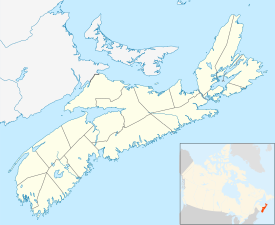Lower Horton, Nova Scotia, Canada
| Wolfville | |||||
|---|---|---|---|---|---|
| Town | |||||

Wolfville streetscape, spring 2006. The view shows the Al Whittle (Acadia) Theatre, a house of movies and live performances now operated by a non-profit cooperative.
|
|||||
|
|||||
| Location of Wolfville, Nova Scotia | |||||
| Coordinates: 45°5′0″N 64°22′0″W / 45.08333°N 64.36667°W | |||||
| Country |
|
||||
| Province |
|
||||
| County | Kings | ||||
| Settled | 1755 | ||||
| Incorporated | March 4, 1893 | ||||
| Government | |||||
| • Mayor | Jeff Cantwell | ||||
| • MLA | Keith Irving (L) | ||||
| • MP | Scott Brison (L) | ||||
| Area (2016) | |||||
| • Land | 6.46 km2 (2.49 sq mi) | ||||
| Highest elevation | 92 m (302 ft) | ||||
| Lowest elevation | 0 m (0 ft) | ||||
| Population (2016) | |||||
| • Total | 4,195 | ||||
| • Density | 649.8/km2 (1,683/sq mi) | ||||
| • Change (2011–16) |
|
||||
| Time zone | AST (UTC-4) | ||||
| • Summer (DST) | ADT (UTC-3) | ||||
| Postal code | B4P | ||||
| Area code(s) | 902 | ||||
| Telephone Exchange | 542, 585, 697 | ||||
| Median Earnings* | $36,979 | ||||
| NTS Map | 021H01 | ||||
| GNBC Code | CBROD | ||||
| Website | www |
||||
|
|
|||||
Wolfville is a Canadian town in the Annapolis Valley, Kings County, Nova Scotia, located about 100 kilometres (62 mi) northwest of the provincial capital, Halifax. The town is home to Acadia University, Landmark East School and the Acadia Cinema Cooperative, a non-profit organization that runs the local movie/performance house. It is a popular tourist destination for the scenery of the nearby Bay of Fundy and Gaspereau Valley, as well as for the many cultural attractions which are offered by the university and town. In the past few years, several Victorian houses in Wolfville have been converted to bed and breakfast establishments.
From ancient times the area of Wolfville was a hunting ground for many First Nations peoples including the Clovis, Laurentian, Bear River, and Shields Archaic groups. They were attracted by the salmon in the Gaspereau River and the agate stone at Cape Blomidon with which they could make stone tools. In around 700 AD, the first Mi'kmaq, related to the Algonquin and Ojibwe peoples, migrated into Nova Scotia and bumped the other tribes out. The Mi'kmaq were seasonal hunters, using dogs and webbed snowshoes to hunt deer, and using the various semi-precious stones (including jasper, quartz, and even amethyst) from the Blomidon area to make arrowheads.
After an initial effort in 1604 by Pierre Dugua, Sieur de Mons and his cartographer Samuel de Champlain to establish a colony at Saint Croix Island the colony was relocated to the Habitation at Port-Royal. The French and the Mi'kmaq quickly established a reciprocal relationship which continued to serve both peoples well until the mid Eighteenth-century. The French found the area to be rich in furs and fine fertile land. Reports sent to France by individuals such as Samuel de Champlain, Marc Lescarbot and Nicolas Denys proclaimed the rich bounty to be found in the Annapolis Valley area.
...
Wikipedia




